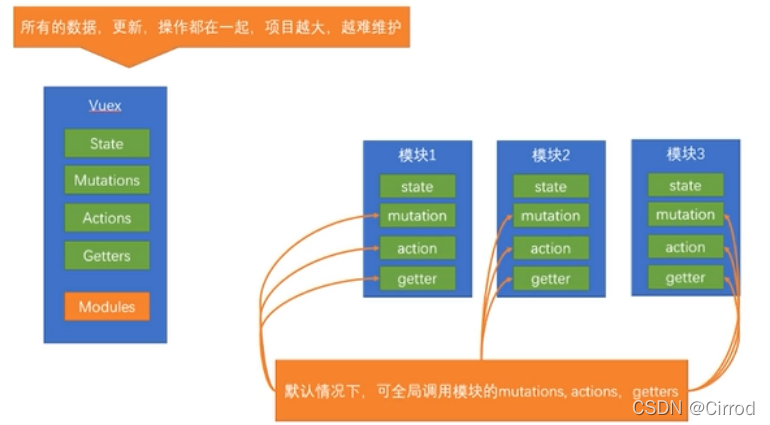一.组件之间共享数据的方式
1.父向子传值:v-bind属性绑定
2.子向父传值:v-on事件绑定
3.兄弟组件之间共享数据:EventBus
$on 接受数据的那个组件
$emit 发送数据的那个组件
二.Vuex是什么
Vuex是实现组件全局状态(数据)管理的一种机制,可以方便的实现组件之间数据的共享。

三.使用Vuex统一管理状态的好处
①能够在vuex中集中管理共享的数据,易于开发和后期维护
②能够高效地实现组件之间的数据共享,提高开发效率
③存储在vuex中的数据都是响应式的,能够实时保持数据与页面的同步
四.什么样的数据适合存储到Vuex中
一般情况下,只有组件之间共享的数据,才有必要存储到vuex中;对于组件中的私有数据,依旧存储在组件自身的data中即可。
五.Vuex的基本使用
1.安装vuex依赖包
npm install vuex --save2.导入vuex包
import Vuex from 'vuex'
Vue.use(Vuex)3.创建store对象
const store=new Vuex.store({
//state中存放的就是全局共享的数据
state:{count:0}
})4.将store对象挂载到vue实例中
new Vue({
el:'#app',
render:h=>h(app),
router,
//将创建的共享数据对象,挂载到Vue实例中
//所有的组件,就可以直接从store中获取全局的数据了
store
})六.核心概念概述
Vuex中的主要核心概念:
①State
②Mutation
③Action
④Gtter
1.State
State提供唯一的公共数据源,所有共享的数据都要统一放到Store的State中进行存储。
//创建store数据源,提供唯一公共数据
const store=new Vuex.store({
//state中存放的就是全局共享的数据
state:{count:0}
})组件访问State中数据的第一种方式:
this.$store.state.全局数据名称组件访问State中数据的第二种方式:
//1.从vuex中按需导入mapState函数
import {mapState} from 'vuex'
通过刚才导入的mapState函数,将当前组件需要的全局数据,映射为当前组件的computed计算属性:
//2.将全局数据,映射为当前组件的计算属性
computed:{
...mapState(['count'])
}2.Mutation
Mutation用于变更Store中的数据。
①只能通过mutation变更Store数据,不可以直接操作Store 中的数据。
②通过这种方式虽然操作起来稍微繁琐一些,但是可以集中监控所有数据的变化。
//定义Mutation
const store = new Vuex.Store({
state:{
count:0
},
mutations:{
add(state){
//变更状态
state.count++
}
}
})在组件中
//触发mutation
methods:{
handle(){
//触发mutations的第一种方式
this.$store.commit('add')
}
}可以在触发mutations时传递参数
//定义Mutation
const store = new Vuex.Store({
state:{
count:0
},
mutations:{
addN(state,step){
//变更状态
state.count+=step
}
}
})在组件中
//触发mutation
methods:{
handel(){
//调用commit函数
//触发mutations时携带参数
this.$store.commit('addN',3)
}
}this.$store.commit()是触发mutations的第一种方式,触发mutations 的第二种方式:
//1.从vuex中按需导入mapMutations函数
import {mapMutations} from 'vuex'通过刚才导入的mapMutations函数,将需要的mapMutations函数,映射为当前组件的methods方法
//2.将指定的mutations函数,映射为当前组件的methods函数
methods:{
...mapMutations(['add','addN'])
}3.Action
Action 用于处理异步任务。
如果通过异步操作变更数据,必须通过Action,而不能使用Mutation,但是在Action中还是要通过触发Mutation的方式间接变更数据。
//定义Action
const store = new Vuex.Store({
//...省略其他代码
mutations:{
add(state){
state.count++
}
},
actions:{
addAsync(context){
setTimeout(()=>{
context.commit('add')},
1000)
}
}
})在组件中
//触发Action
methods:{
handle() {
//触发actions的第一种方式
this.$store.dispatch('addAsync')
}
}触发actions异步任务时携带参数:
//定义Actions
const store =new Vuex.Store({
//省略其他代码
mutations:{
addN(state,step) {
state.count+=step
}
},
actions:{
addNAsync(context,step) {
setTimeout(()=>{
context.commit('addN',step)
},1000)
}
}
})在组件中
//触发Action
methods:{
handle() {
//在调用dispath函数
//触发actions时携带参数
this.$store.dispatch('addNAsyc',5)
}
}this.$store.dispatch()是触发actions的第一种方式,触发actions的第二种方式:
//1.从vuex中按需导入mapActions函数
import {mapActions} from 'vuex'
通过刚才导入的mapActions函数,将需要的actions函数映射为当前组件的methods方法
//2.将指定的actions函数,映射为当前组件的methods函数
methods:{
...mapActions(['addASync','addNASync'])
}4.Getter
Getter用于对Store 中的数据进行加工处理形成新的数据。
①Getter可以对Store 中已有的数据加工处理之后形成新的数据,类似Vue的计算属性。
②Store 中数据发生变化,Getter的数据也会跟着变化。
//定义Getter
const store = new Vuex.Store({
state:{
count:0
},
getters:{
showNum:state=>{
return '当前最新的数量是'+state.count+''
}
}
})使用getters的第一种方式:
this.$store.getters.名称使用getters的第二种方式:
import {mapGetters} from 'vuex'
computed:{
...mapGetters(['showNum'])
}5.Moudule
由于使用单一状态树,应用的所有状态会集中到一个比较大的对象。当应用变得非常复杂时,store对象就有可能变得相当复杂。
这句话的意思是,如果把所有的状态都放在state中,当项目变得越来越大的时候,Vuex会变得越来越难以维护。由此,又有了Vuex的模块化

例子:
定义两个模块user和setting
user中管理用户的状态token
setting中管理应用的名称name
const store = new Vuex.Store({
modules:{
user: {
state:{
token:'123456'
}
},
setting:{
state:{
name:'hsq'
}
}
})在组件中使用:
<div>用户token{{$store.state.user.token}}</div>
<div>网站名称{{$store.state.setting.name}}</div>注意:这时候获取子模块的状态需要通过$store.state.模块名称.属性名称来获取
看着获取有点麻烦,我们可以通过之前学过的getter来改变一下
getters: {
token: state => state.user.token,
name: state => state.setting.name
}注意:这个getter是根级别的getter
通过mapGetters引用
computed: {
...mapGetters(['token','name'])
}6.Moudule中的命名空间
命名空间 namespaced
默认情况下,模块内部的action、mutation和getter是注册在全局命名空间的——这样使得多个模块能够对同一mutation或 action 作出响应。
这句话的意思是刚才的user模块还是setting模块,它的action、mutation和getter其实并没有区分,都可以直接通过全局的方式调用

例子:
user: {
state: {
token: '12345'
},
mutations: {
//这里的state属于user模块
updateToken (state) {
state.token='678910'
}
}
}通过mapMutations调用
methods:{
...mapMutations(['updateToken'])
}
<button @click="updateToken">修改token</button>但是,如果我们想保证内部模块的高封闭性,我们可以采用namespaced来进行设置
高封闭性?可以理解成一家人如果分家了,此时,你的爸妈可以随意的进出分给你的小家,你觉得自己没什么隐私了,我们可以给自己的房门加一道锁(命名空间namespaced),你的父母再也不能进出你的小家了
如
user: {
namespaced:true,
state: {
token: '12345'
},
mutations: {
//这里的state属于user模块
updateToken (state) {
state.token='678910'
}
}
}通过给模块namespaced:true之后,在全局就不能直接引用模块内部的函数等等东西,
这时候如果想调用模块内部,这里有三个方案
方案一:直接调用-带上模块的属性名路径
test (){
this.$store.dispath('user/updateToken')//直接调用方法
}方案二:辅助函数-带上模块的属性名路径
methods: {
...mapMutations(['user/updateToken']),
test () {
this['user/updateToken']()
}
}
<button @click="test">修改token</buton>方案3:createNamespacedHelpers 创建基于某个命名空间辅助函数
import {mapGetters,createNamespacedHelpers} from 'vuex'
const {mapMutations} = createNamespaceHelpers('user')
<button @click="updateToken">修改token</button>























 1490
1490











 被折叠的 条评论
为什么被折叠?
被折叠的 条评论
为什么被折叠?










